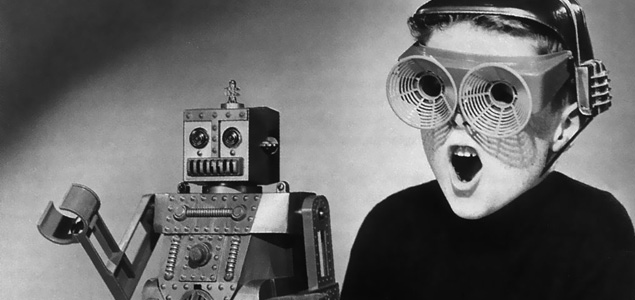
Advertisment of “Robert the Robot” from the Ideal Toy Corporation. Source: Flickr.
Science fiction allows us to lose ourselves in extraordinary stories and at the same time learn about science in an entertaining way. The fictional worlds of films like Blade Runner, Foundation, Interstellar, and Solaris have led many people to embark on research in fields as diverse as physics, robotics and neuroscience on their own account after the final credits rolled. If cultural institutions manage to adapt to meet these needs, and complement this learning process through different narrative formats, we will achieve barrier-free education that goes from the armchair at home to museums and libraries.
My granny asking me about black holes. Before the release of Interstellar nobody would have imagined that I would ever be part of such a touching scene. But as it turns out, the film was not just a genuine science fiction phenomenon that has been compared to 2001: A Space Odyssey, it also provoked innumerable discussions about time travel and those blasted black holes. If only for bringing theoretical physics and astronomy experts closer to ordinary mortals, Interstellar deserves to inaugurate a new Oscar for the most informative film (and to be automatically named the first winner). Just look at the discussions that have taken place around the scientific rigour of the film, the screenings at the National Air and Space Museum, and the book published by director Christopher Nolan’s scientific consultant for the film, Kip Thorne. And Neil deGrasse Tyson, of course. There’s always Neil.
My grandmother’s case is just one example of the power of these kinds of works to make science attractive. It’s time to get rid of the idea that science fiction is a minor genre made by weirdos for weirdos. Whether it is due to a growing respect for science over the last few years or to the normalisation of these types of stories, the fact is that the popularity of science fiction is booming. At a time when we are overexposed to narratives in all areas of life – books, television, film, the political sphere – our minds appear to be increasingly willing to live with all of them and seem hungry for more, as though stories were fuel. Putting ourselves in the shoes of people – or beings, we wouldn’t want to hurt extraterrestrial sensibilities – who live thousands of kilometres from our planet or perhaps thousands of years before (or after) our own time, is a way of experiencing situations that we would never be exposed to in everyday life. Who wouldn’t want to enjoy these types of adventures, totally risk-free?
Science fiction is a kind of fiction after all, and that is exactly what fiction allows us to do: to live the lives of the characters for as long as the film, the book, the graphic novel, or the series last. This mind-transfer effect – which we are gradually learning more about thanks to interdisciplinary studies that combine neuroscience and fiction theory – is proving to be much more than the simple pleasure of sitting down to enjoy our favourite fiction piece. Just as a flight simulator allows us to pilot a plane without stepping into a real cockpit – and thus without danger – we can see fiction as a simulator of other lives through which we learn to function in society (that’s right, reading ends up being a social activity) without running the risks of these fantasy environments.
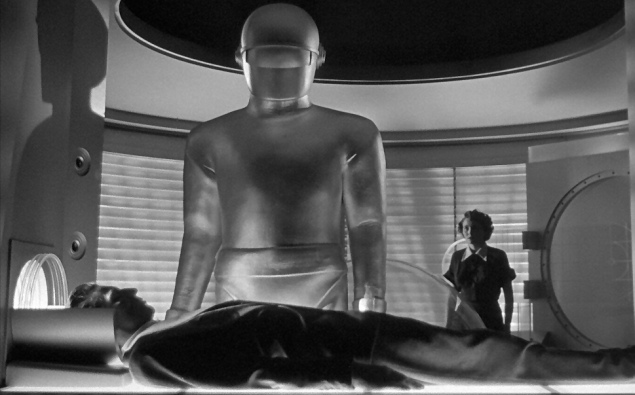
Frame from The Day The Earth Stood Still. Source: Flickr.
But beyond this social learning, fictional works always teach us things linked to the specific universe they create. A reader of Charles Dickens can knowledgeably talk about Victorian society, and a Tolstoy fan will be familiar with some of the customs of the Russian bourgeoisie during their copious banquets. Stories in themselves are small history classes (or classes on engineering, or botany, or…), and they are generally more entertaining than most master classes. It is a pleasure to learn like this.
There are also big risks involved in learning through fiction of course, let’s not fool ourselves. When the film Lucy was released, the unfounded rumour that we only use 10% of our brains was reawakened Phoenix-like and left its mark on the minds of countless viewers who heard the words of the character played by Morgan Freeman and thought “hey, an actor playing a scientist said it, so it must be true.” Ensuring that readers and viewers have a sound base that allows them to identify these fallacies is a big challenge for families, schools, colleges, and other cultural institutions.
Along the lines of the participatory idea according to which readers actually experience the stories they read, there are already projects that make learning history more palatable through virtual or augmented reality systems that (finally) allow students to leave behind tedious classes full of dates and places that they forget as soon as they pass the exam. The technologies required for this paradigm change may still be in development stage, but our minds have been eagerly awaiting them for some time. Think of the many science fiction readers who have decided to embark on a scientific career thanks to Isaac Asimov, Arthur C. Clarke or Philip K. Dick, although we don’t need to go into a lab to find diehard fans. A few months ago, I eagerly followed angry discussions on Twitter about time travel on the Spanish series El Ministerio del Tiempo. And as a result, historical figures like Velázquez and Lope de Vega became trending topics because they featured in some of the episodes.
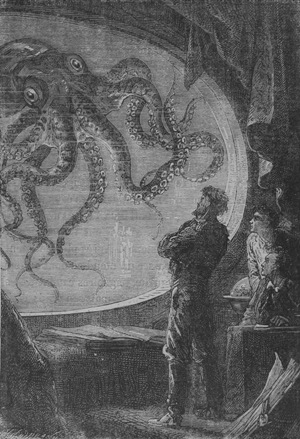
Illustration from Jules Verne’s Twenty Thousand Leagues Under the Sea. Source: Wikipedia.
It is truly exciting to think about the potential of a transmedia narrative that begins as a book or a film, spreads to comics and videogames, and ends up in cultural institutions that find ways to feed the thirst for knowledge of young people and adults. This text began by talking about the case of Interstellar, but there are other projects that are much nearer to the scientific field. The magazine Twelve Tomorrows published by MIT Technology Review, for instance, is a kind of anthology in which science fiction authors write short stories based on the scientific advances and technologies that have been discussed in the journal over the previous year. Just imagine the educational potential of these types of projects! Young people (and not-so-young people) inspired to take an interest in science after reading a short story or watching a film. Then buying the graphic novel that extends part of the plot and explains how the spaceship or weapon that will save the world was built. And ending up at a museum, where augmented reality technology allows them to see the main character explaining the physics concepts that allowed his or her ship to travel light years from our planet. Add immersive virtual realities that allow us to move at will through other times and places, and season the mix with interactive films in which we are the protagonists of space missions or journeys to the heart of the atom. It’s just around the corner, so get ready. You don’t want to get caught out thinking it’s science fiction.

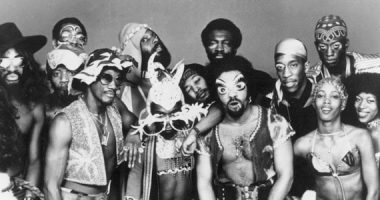

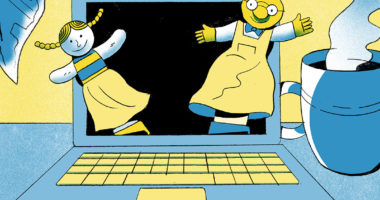

Leave a comment